.
The Pnyx (Greek Πνυξ, pronounced "Pnooks" in Ancient Greek, "Pniks" in Modern Greek), is a hill in central Athens, the capital of Greece. It is located less than one kilometre west of the Acropolis, and 1.6km south-west of the centre of modern Athens, Syntagma Square.
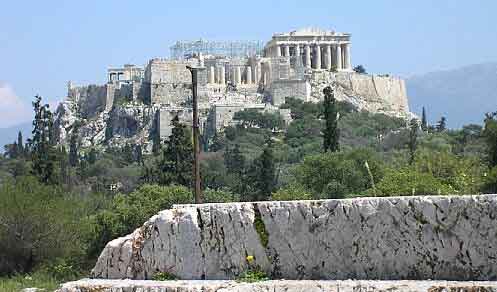
The speaker's platform at the Pnyx, with the Acropolis in the background.
The site
Compared to the better known surviving monuments of ancient Athens, such as the Parthenon, the Pnyx is unspectacular. It is a small hill surrounded by parkland, with a large flat platform of eroded stone set into its side. But it is one of the most significant sites in the city, and indeed in the world. For the Pnyx was the meeting place of the world's first democratic legislature, the Athenian ekklesia (assembly), and the flat stone is the bema or speaker's platform.
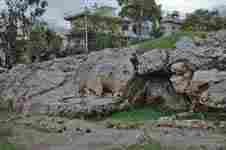
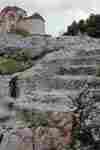
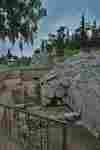
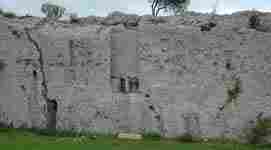

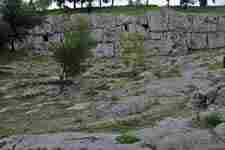
The Pnyx was used for popular assemblies in Athens as early as 507 BC, when the reforms of Cleisthenes transferred political power to the citizens. It was then outside the city, but close enough to be convenient for the citizens. It looks down on the ancient Agora, the commercial and social centre of the city.
At this site all the great political struggles of Athens of the "Golden Age" were fought out. Statesmen such as Pericles, Aristides and Alcibiades would have spoken here regularly, with the Parthenon, Temple of Athena the Virgin, the city's protective goddess, looking down on their deliberations.
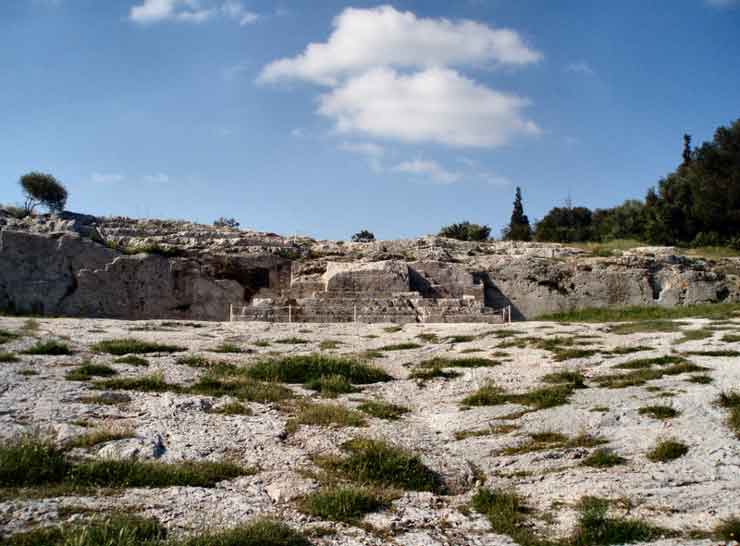
The Pnyx
Athenian democracy
The grassy area in front of the bema was in ancient times an area of bare rock, in which about 6,000 men could stand. This can be taken as a reasonable estimate of the number of politically active citizens (citizens were free males born in the city, or perhaps 20% of the adult population). There were wooden seats for the members of the Council of 500, who were elected by the ekklesia to run the city on a day-to-day basis. In later times two stoas, or covered galleries, were built to protect the dignitaries against the rain and sun.
In theory all citizens were equal, and all had the right to speak. In practice Athens was a hierarchical society like any other, and those recognised as leaders tended to dominate proceedings. Many of these belonged to the old aristocratic families which had ruled Athens before the advent of democracy, but the poor and the unknown citizen could sometimes rise to prominence if he spoke well and captured the mood of the assembly. There was a rule that citizens aged over 50 had a right to be heard first.
Democratic government at Athens was suspended in 404 BC following the city's defeat by Sparta in the Peloponnesian War. The Spartans and their allies in Athens installed a dictatorship, called the Rule of the Thirty, but in 402 the democrats seized power again and the meetings at the Pnyx resumed. Athenian democracy continued until Athens lost its independence to Philip II of Macedon after the battle of Chaeronea in 338 BC.
Excavations
Excavations at the site were begun in 1910 by the Greek Archaeological Society and definitely confirmed the site as the Pnyx. Large-scale excavations were conducted at various times between 1930 and 1937 by Homer Thompson, in collaboration first with K. Kourouniotes and later with Robert Scranton.
These excavations discovered the foundations of the important buildings at the Pnyx, although nothing else remains of them. These included the two large stoas, erected between 330 and 326 BC, the Altar of Zeus Agoraios, erected at the same time, but removed during the reign of Augustus (first century BC), and the Sanctuary of Zeus Hypsistos. Most of these buildings were erected after the Pnyx had lost its real significance.
Today the site of the Pnyx is under the control of the Ephorate of Prehistorical and Classical Antiquites of the Greek Ministry of Culture. The surrounding parklands are fenced, but the traveller can visit it free of charge at any time during daylight.
J. W. McGarvey, Lands of the Bible
As I sat on Mars Hill I could see distinctly, on lower ground, and about 300 yards to the southwest, the celebrated Pnyx, a semicircular space in the open air where the Athenians used to assemble to hear the speeches of their great orators. The space was made level by cutting a broad bench on the hill-side, and where the cutting in the rock was made, a platform of the natural rock, 10 feet high and 9 feet by 11 on top, was left projecting into the semicircular space like the platform of a modern pulpit. On this rock pulpit, called the Beema by the Greeks, which had steps to ascend it on the right and the left, Demosthenes and the other orators stood while they thundered their eloquence in the ears of the people. When I stood there and looked out on the semicircular area which accommodated an audience of 7000 people, a strong north wind was blowing in my face, and I did not wonder that Demosthenes felt the need of strengthening his voice by practicing on the seashore where the surf was rolling in, so that he might be able to make himself heard in this auditorium. It was interesting to stand on his pulpit and look up to Paul's, or on Paul's and look down upon his, while I mentally traced the contrast between the greatest of heathen and the greatest of Christian orators.
Literature
- Robert A. Moysey: The Thirty and the Pnyx, in: American Journal of Archaeology 85 (1981).
- Homer A. Thompson: The Pnyx in Models, in: Hesperia Suppl. 19 (1982).
- Susan I. Rotroff / John McK. Camp: The Date of the Third Period of the Pnyx, in: Hesperia 65 (1996).
- Björn Forsén, Greg Stanton (Hrsg.): The Pnyx in the History of Athens. Proceedings of an International Colloquium organised by the Finnish Institute at Athens, 7 - 9 October, 1994 (1996).
Image of Pnyx from 1870
| Ancient Greece
Science, Technology , Medicine , Warfare, , Biographies , Life , Cities/Places/Maps , Arts , Literature , Philosophy ,Olympics, Mythology , History , Images Medieval Greece / Byzantine Empire Science, Technology, Arts, , Warfare , Literature, Biographies, Icons, History Modern Greece Cities, Islands, Regions, Fauna/Flora ,Biographies , History , Warfare, Science/Technology, Literature, Music , Arts , Film/Actors , Sport , Fashion --- |

